Basics Of Financial Management - Boeken
Basicsof FinancialManagementANSWERS AND SOLUTIONSRien Brouwers MSc.Wim Koetzier MSc.Olaf Leppink MSc.First Edition
Noordhoff Uitgevers bvBasics of FinancialManagementAnswers and solutionsRien Brouwers Msc.Wim Koetzier Msc.Olaf Leppink Msc.First editionNoordhoff Uitgevers Groningen/Houten
Noordhoff Uitgevers bvCover design: G K Designers, Groningen/AmsterdamCover illustration: iStockphotoAny comments about this publication or others may be addressed to:Noordhoff Uitgevers bv, Afdeling Hoger Onderwijs, Antwoordnummer , VBGroningen, e-mail: info@noordhoff.nl / Noordhoff Uitgevers bv Groningen/Houten, The Netherlands.Subject to the exceptions in or pursuant to the Auteurswet (Copyright Act) of , nopart of this publication may be reproduced, stored in an automated retrieval system ormade public in any way, either by electronic or by mechanical means, by photocopying,recording or otherwise, without the prior written permission of the publisher. To theextent that reprographic reproduction of this publication is permitted pursuant to Article h Auteurswet (Copyright Act ), the compensation payable is to be made to theStichting Reprorecht (postbus , KB Hoofddorp, www.cedar.nl/reprorecht).Anyone wishing to reproduce part(s) of this publication in anthologies, readers andother compilations (Article Auteurswet ) may apply to the Stichting PRO (Stichting Publicatie- en Reproductierechten Organisatie, P.O. Box , KB Hoofddorp,www.cedar.nl/pro).All rights reserved. No part of this publication may be reproduced, stored in a retrievalsystem, or transmitted, in any form or by any means, electronic, mechanical, photocopying, recording, or otherwise, without the prior written permission of the publisher.ISBN (ebook) - - - - ISBN - - - - NUR
Noordhoff Uitgevers bvPreface first editionIn Answers and solutions, the answers to all the preparatory questions in theexercise book are provided. It is recommended to try as much as possible, tofirst solve these questions without any help, and to check the answers byusing this answer book.Furthermore, a large number of answers to Exercises are also included inthis book. Generally speaking, these questions (indicated with an E in theexercise book), are at examination level. To ensure that the subject materialis fully mastered, it is essential to make at least one exercise of each topicdiscussed in the theory book and then check the answer.Finally, a limited number of solutions to the case studies (indicated with a Cin the exercise book) are included, linking the topic to previously studiedparts of the subject material.With the translation of Exercises to Basics of Financial Management, Answersand solutions were also translated. This first edition matches the secondedition of the exercise book.Answers and solutions intends to facilitate the student’s active approach.During lectures there is often (too) little opportunity to discuss a sufficientnumber of exercises. With the assistance of the answer book, the studentcan independently work on exercises and receive feedback on the accuracyof the calculations.In this edition, a summary of each chapter of Basics of Financial Management is included.We hope that this instruction can contribute to a positive study result forfinancial management.The authors
Noordhoff Uitgevers bvSeries OverviewBasics of Financial Management - - - - Basics of Financial Management - Exercises - - - - Basics of Financial Management - Answers and solutions - - - -
Noordhoff Uitgevers bvContentsPART 1Financial management in business Summary chapter - 1Businesses and their role in the economy Answers to preparatory questions Answers to exercises 2Financial management disciplines and positions Answers to preparatory questions 3Financial statements Answers to preparatory questions Answers to exercises Answers to case studies 4Business Plan Answers to preparatory questions Answers to exercises PART 2Finance Summary Chapter - 5Capital Budgeting Answers to preparatory questions Answers to exercises 6Working capital management Answers to preparatory questions Answers to exercises 7Equity Answers to preparatory questions Answers to exercises 5
Noordhoff Uitgevers bv689Liabilities Answers to preparatory questions Answers to exercises Assessment of the financial structure Answers to preparatory questions Answers to exercises 10Financial markets Answers to preparatory questions Answers to exercises PART 3Management accounting Summary chapter - 11Cost structure Answers to preparatory questions Answers to exercises Answers to case study 12Cost calculations Answers to preparatory questions Answers to exercises Answers to case studies 13Indirect costs Answers to preparatory questions Answers to exercises Answers to case study 14Budgeting and variance analysis Answers to preparatory questions Answers to exercises Answers to case study PART 4Financial accounting Summary chapter - 15Financial accounting Answers to preparatory questions Answers to exercises
Noordhoff Uitgevers bv16A closer look at financial statements Answers to preparatory questions Answers to exercises Answers to case study 17Cash flow statement Answers to preparatory questions Answers to exercises 18Corporate accounting Answers to preparatory questions Answers to exercises 7
Noordhoff Uitgevers bvPART 1Financialmanagementin business9
10PART 1FINANCIAL MANAGEMENT IN BUSINESS Noordhoff Uitgevers bvSummary chapter 1 Businesses and their role in the economyA company is a production organization which manufactures goods andprovides services to consumers with the aim to make a profit. Financialmanagement focuses on the economic conduct within these organizations.The three disciplines which can be distinguished are financing, management accounting and financial accounting.To generate profit, a surplus of revenue above costs is required for thecontinuity of the company. In the striving for profit, effectiveness andefficiency of the production process play, a key role.Organizations without the aim to generate profit are called non-profitorganizations These are from an economic point of view, not self reliantorganizations, as they depend on for example, general resources (taxmoney), contributions, donations and subsidies. These organizations canbe divided into governmental and private non-profit organizations. Thegovernment supplies mainly collective goods and services, such as zoningplans, fire services and education. The private non-profit sector consists ofa large variety of organizations. Examples of these are associations andcharitable organizations.The activities performed by these companies can be divided into agricultureand mining, industry, trade and service industry. The nature of theseactivities is determined for the production factors which the company usesand which investments are required.Typical for the agricultural and mining sector is that hardly any use ismade of commodities. Nature is used as a production factor. In industrialcompanies, a distinction can be made between job production, massproduction, series job production and batch production. This distinction isbased on the question to what level the specific customers wishes need tobe taken into consideration with regards to the production.The trade industry ensures the distribution of products: goods arepurchased from suppliers and sold to customers. Trading companies canbe divided into wholesaler (sales to other companies) and retailing services(sales to consumers).Service rendering companies do not actually transfer goods, the service isthe product they deliver. Companies of various nature belong to the serviceindustry.Companies can be divided into: Those without legal entity: sole proprietorship, partnership or limitedpartnership. Legal entities: the limited liability company, the public limited companyand the cooperative association.The sole proprietorship has the most important characteristic, in that control and ownership of the company remain with one person. The qualities,but also the health of this person determine the success of the company.The partnership is a cooperation between two or more persons. In thepartnership, the partners are severally liable for the liabilities.The limited partnership is a cooperation between persons, of which at leastone partner is owner but does not have control of the company. The responsibility of this partner is limited to the capital which was invested by him.
Noordhoff Uitgevers bvSUMMARYThe partnership of professionals is a form of cooperation between individuals practicing the same profession. In this type of partnership, the partnersare each liable for a share of the debts.For all the companies previously mentioned applies that the owner(s) areeligible for income tax in box .In the public limited company there is a distinction between the ownershipand the control of the company. The ownership lies with the shareholders,who have jointly raised the equity of the company. The control of the company lies with the board of directors, assigned and paid by the company.This also applies to the limited liability company. Nowadays, the publiclimited company is only used for share-exchange listing. Both the publiclimited company and the limited liability company are subject to corporatetaxes. Shareholders who hold at least % of the capital share, are taxed inbox for income tax, all other shareholders in box .The cooperative association is a cooperation of persons, intended to act forthe benefit of the mutual interest of its members. The equity of the cooperative association is gathered by its members. Control lies with the electedboard of directors and an assigned management.All companies have to deal with value added tax (VAT). A company thatmakes a sale, is liable for value added tax on its sales revenue. This tax willbe recharged to the buyer. If the buyer is a company, then it can reclaim thecharged value added tax from the tax authorities. The consumer is the payerof this value added tax, as he cannot reclaim it. Value added tax has both anormal rate and a low rate.Between many companies there exists a type of labor division: one company operates in the textile sector, the other in the building industry and athird is part of the service industry. Generally speaking, each individualcompany is only one chain in the total process which a product goesthrough until it reaches the consumer. This chain from initial manufacturerto the final supplier and the customer is called the supply chain. Companieswhich belong to the same level of a supply chain and therefore perform thesame production process, are called a business sector or industry.This work allocation is continuously changing, as there are many forms ofcooperation between companies, such as mergers, franchising or cartelagreements.Summary chapter 2 Financial management disciplines andpositionsThe discipline financial management is divided into three parts: Finance focuses on the investments required by the company, and themanner in which these investments can be best financed. Management accounting concerns the (financial) reporting to companymanagement, for allowing responsible decision making. Financial accounting concerns external financial reporting to shareholders, employees, creditors, financial press and other stakeholders. For thispurpose the annual report is drawn up.11
12PART 1FINANCIAL MANAGEMENT IN BUSINESS Noordhoff Uitgevers bvBetween management accounting and financial accounting, there are twomajor differences.Firstly, in financial accounting legislation dictates which information has tobe published by the company. In management accounting, this is not thecase. Secondly, in financial accounting it should be considered that company management does not give an actual representation of the financialposition, but a more flattering result by the use of creative accounting.Management accounting implies that company management wishes toknow the actual status of affairs, therefore there is no need to present thecompany in a better light.Topics related to financial management are: Bookkeeping or business administration: this subject focuses on the registration of the primary data, based on these, management accountingand financial accounting can proceed. Company law: this is important for finance (legal entity of companies)and financial accounting (disclosure requirements). Tax law Organizational structures and behavior MarketingAn important financial management function in the field of finance is thetreasurer, who occupies himself with the optimum development of thecash flow of the company. The controller is the focal point of managementaccounting. He assures among others, that there is an efficiently operatingbudgeting system. The accountant is active in the field of financial accounting. The internal auditor focuses internally on the auditing of financialaccounts. The external accountant works at an accountancy firm and performs (for some companies legally required) the audit of the financialstatements.Summary chapter 3 Financial statementsOn the balance sheet, is indicated which investments have been madeby a company (debit side) and in which manner these have been financed(credit side).The investments are called assets and are divided into fixed assets (ofservice for more than a year) and tangible assets (of service for maximuma year).For the method of financing, a distinction can be made between equity andliabilities.Equity has been made available to the company by the owner(s) for anunlimited period of time. The remuneration they will receive for makingthis available, is the profit. Equity is risk-bearing capital, because the remuneration is not fixed and in the event of a bankruptcy the equity providersonly receive their investment back after all other creditors have been paid.Liabilities are loans made available for a particular period of time by creditors. Their revenue is interest, as it is determined in advance and in theevent of bankruptcy they will be repaid first. Liabilities are considered to berisk avoiding capital.
Noordhoff Uitgevers bvSUMMARYBy comparison of equity at two balance sheet moments, the profit can becalculated. In principle, an increase of equity is the profit. However, if one ofthe owners has withdrawn or deposited money, a correction must be made.The profit can also be determined by drawing up a income statement,which is a confrontation of the sales revenue and the cost during a particular period.Sales revenue is not necessarily equal to cash inflows. The sales revenue dueto sales transactions, should be recognized at the moment that the companyhas delivered the performance, even if the buyer has not yet paid.By definition, costs are not equal to cash outflows. Costs are taken whenthe actual use of a production factor occurs, regardless of the moment ofpayment.The profit, as shown in the income statement, is not necessarily equal to themutations in cash and cash equivalents.Depreciation is a cost, but not cash outflow. Through depreciation, thepurchase price of a production factor is divided over the years during whichthe production factor delivers a performance.Possible depreciation systems: Straight-line depreciation: every year the same amount is depreciated. Accelerated depreciation: during the initial years more is depreciatedthan in later years. This can be achieved by applying the sum-of-theyears-digit method, or the book value method. Depreciation based on usage.Provisions are recognized for possible future obligations, of which the originis in the financial year concerned. Costs are now already recognized, while(possible) expenditure will only occur in future.Summary chapter 4 Business PlanWhoever starts a company, benefits from a well thought through businessplan.For a company, the plan acts a check list and an instrument to assess thefeasibility of the enterprise. For possible money lenders, the plan is a meansto be persuaded.Venture capital companies are specialized in the financing of starting businesses.In a business plan the following is included: The qualifications of the starting entrepreneur: background information,education, experience. Market and marketing mix, activities to be performed, marketing mix (thefour Ps) and market research. Legal aspects (legal form, required permits). Organizational structure. Finance: investment plan, financing plan, cash flow forecast, estimatedbalance sheet, estimated income statement.13
Noordhoff Uitgevers bv151Businesses and their rolein the economy1
16PART 1FINANCIAL MANAGEMENT IN BUSINESS Noordhoff Uitgevers bvAnswers to preparatory questions . A production organization striving for profit. . The striving for profit will usually be focused on the long term, and a relationship of trust with customers is required to achieve this. It is possibleto generate more profit in the short term, for example by misleading advertising, but this is avoided due to the focus on the long term. Furthermore,there are other objectives, such as attention to employment and theenvironment. . Effectiveness is the extent to which the desired objective is achieved, ‘doingthe right thing’. Efficiency is the extent to which resources are used to achievethe objective, ‘doing things right’. Accordingly, effectiveness is about whetherthe objective is reached, and efficiency about the costs involved.1 . a Eneco is a company, and is a PLC of which the majority of shares is held byDutch municipalities.b The municipal police are a non-profit organization and fully subsidized bythe government.c The Dutch Railways is a company, and is a PLC with one single shareholder,the Dutch Government.d Technical University Inholland is a non-profit organization, mainly subsidized by the government.e The Red Cross is a non-profit organization, mainly financed by donations. . a The fire brigade: time between alert and arrival in event of a fire.b Social rehabilitation services: percentage of ex-convicts remaining ‘on thestraight and narrow’.c The Kidney Foundation: increase in percentage of cured kidney diseases. . a Hagemeyer: wholesaler.b Philips: industry.c De Bijenkorf: retail trade . a Motor vehicle manufacturing: batch production.b Compost production: mass production.c The painting of a family portrait on commission: job production. . a Owner of sole proprietorship: income tax box over profit.b Managing director and shareholder LLC: Corporate tax on profit LLC,income tax box on salary, income tax box on dividend or sales revenueshares.c Private investor: income tax box over flat rate dividend yield. . Member of a cooperative with excluded liability and shareholder LLC. . abcdFree of value added tax.Zero rate.Standard rate, in the Netherlands %.Reduced rate, in the Netherlands %.
Noordhoff Uitgevers bv . BUSINESSES AND THEIR ROLE IN THE ECONOMYa VAT payableVAT reclaimable % of % of VAT on balance to be paid to the tax authoritiesb Sales revenue bicyclesPurchase price sold bicyclesProfit . . , , , , , , 1a A garden center selling Christmas items: horizontal integration.b Mobile phone provider taking over a competitor: expansion in the sameindustry.c Mail order company making its own deliveries: vertical integration.From a legal point of view, the franchisee is an independent entrepreneur.He/she works for his/her own account and risk. From an economic point ofview, the entrepreneur is also dependent on the franchiser (the chain), whosells the store concept and often determines the purchasing and marketing.This requires teamwork and is sometimes difficul
With the translation of Exercises to Basics of Financial Management, Answers and solutions were also translated. This first edition matches the second edition of the exercise book. Answers and solutions intends to facilitate the student’s active approach. During lectures there is often (too) little opportunity to discuss a sufficient number of exercises. With the assistance of the answer .
De apocriefe boeken waren van oudsher in binnen- en buitenland altijd in één band met canonieke uitgegeven. Wanneer de Nederlanders van dit gebruik zouden afwijken, dan kon dit lichtelijk een oorzaak van ergernissen en lasteringen worden. "En hoewel te wensen ware, dat al deze Apocriefe boeken nooit bij de heilige Schriftuur .File Size: 1MBPage Count: 334Explore furtherApocriefe geschriften - Statenvertaling on linewww.statenvertaling.netDe apocriefe boeken - Bijbel en Geloofwww.bijbelengeloof.comDe apocriefe boeken en andere - HOLYHOME.NLwww.holyhome.nlRecommended to you b
boeken der wijsheid. Zij bevatten het boek Job (Arabisch: Ajjoeb), de Psalmen (Zaboer), bestaande uit 150 gedichten of geestelijke liederen, en de drie boeken van Salomo, waarvan het grootste het boek der Spreuken is. Deze boeken worden gevolgd door de boeken van de profeten, zestien in get
de derde disputatie over de canonieke en apocriefe boeken (1620) in de twintigste stelling het volgende voor:1 aanvankelijk bestonden de canonieke boeken, en dus de canon, alleen uit de boeken van Mozes.2 Daar kwamen later wel allerlei groepen van boeken bij, zowel in het Oude als da
De Statenvertalers namen ook de apocriefe boeken erbij, omdat ze die toch enigszins hoogachten! Waarom zijn er pas na duizend jaar boeken teruggevonden in Ethiopië, in Slavische landen, en ook een Hebreeuws exemplaar, bij de Dode-Zeerollen. In een van die boeken s
Het bewijs daarvan ligt bovendien in de boeken zelf. Want zelfs blinden kunnen tasten dat de dingen die erin voorzegd zijn, gebeuren. Artikel 6 - Het onderscheid tussen de canonieke en de apocriefe boeken Wij onderscheiden deze heilige boeken van de apocri
boeken daarin geen 39, zoals bij ons, maar 24. Hoe zit het dan met de zogenaamde Apocriefe boeken, die in de periode tussen onze twee Tes-tamenten ontstonden? Volgens het getuigenis van zowel Joden als Chris-telijke leiders uit de eerste paar eeuwen van onze jaartelling, werden deze boeken
Python Basics.ipynb* Python Basics.toc* Python Basics.log* Python Basics_files/ Python Basics.out* Python_Basics_fig1.pdf* Python Basics.pdf* Python_Basics_fig1.png* Python Basics.synctex.gz* Python_Basics_figs.graffle/ If you are reading the present document in pdf format, you should consider downloading the notebook version so you can follow .
Cambridge Manuals in Archaeology is a series of reference handbooks designe fodr an international audience of upper-level undergraduate and graduate students and , professional archaeologist ands archaeologica l scientist isn universities, museums, research laboratorie and fields units. Each book include a surve oysf current archaeological practice alongside essential referenc on contemporare .























